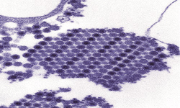Pathogen and transmission
The chikungunya virus is a member of the Togaviridae family. It is spread by female mosquitoes of the Aedes genus, primarily by Aedes albopictus but also by Aedes aegypti.
Pathology
The disease generally develops between 7 and 9 days (in rare cases between 3 and 12 days) after being bitten by an infected mosquito, with symptoms that include a high fever, severe joint and muscle pain and headache, sometimes accompanied by a skin rash. The disease is not generally dangerous; but in a few cases it can lead to long-lasting fatigue and debilitating joint pain that can persist for weeks or months. Some cases of severe disease development have also been observed in newborns, older persons and people with chronic illnesses.
Since no effective medication for chikungunya exists yet, only symptoms can be treated. Pain can be managed with fever-reducing and analgaesic medications. Salycilate-based medications should be avoided in view of their blood-thinning effects.
Distribution and frequency of occurrence
Chikungunya is endemic in numerous African countries, in India and in the Pacific. The chikungunya virus has also established itself in Central America, the Caribbean, parts of South America and some states in the southern USA. Europe, too, has seen cases of transmission: Italy, for example, experienced outbreaks extending to several hundred cases in 2007 and again in 2017; and isolated cases have also been reported from France in the past few years.
All people presenting with chikungunya in Switzerland had been infected during travel elsewhere: no case of transmission within the country has been recorded to date. But the Aedes mosquitoes which have been brought into Europe are spreading in Switzerland, too. The Asian tiger mosquito has already established itself in various parts of the country. The Asian bush mosquito, Aedes japonicus, can also be found in some regions; and a few examples of the Korean bush mosquito, Aedes koreicus, have also been detected. All of these are also known to spread chikungunya, at least under laboratory conditions. So there is a risk of contracting chikungunya in Switzerland; but only a minimal one, and only under certain conditions. To pass on the virus, for instance, the mosquito would first have to have bitten an already infected person who has returned from a chikungunya region.
Prevention
There is a risk of contracting chikungunya in any region where the chikungunya virus is endemic. The only effective means at present of preventing infection when travelling to such regions is protection against mosquito bites: wearing long-sleeved clothing and loose-fitting garments sprayed with insecticide, applying mosquito repellent during the day and in the evenings, and sleeping under a mosquito net.
For further information on the global distribution of chikungunya and ways and means to avoid chikungunya infection, consult your GP or a doctor specialising in travel medicine (see also the Healthytravel website).


